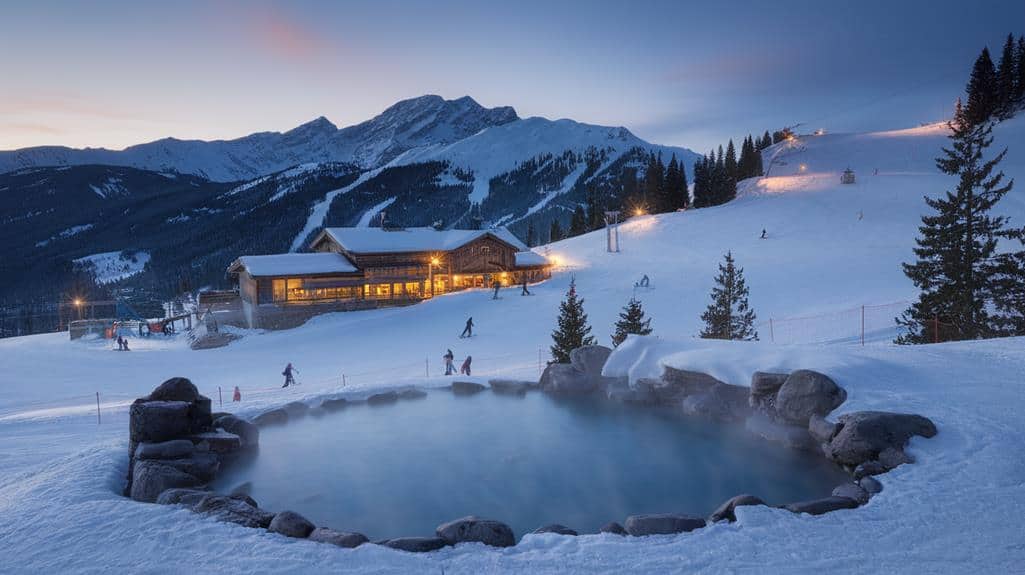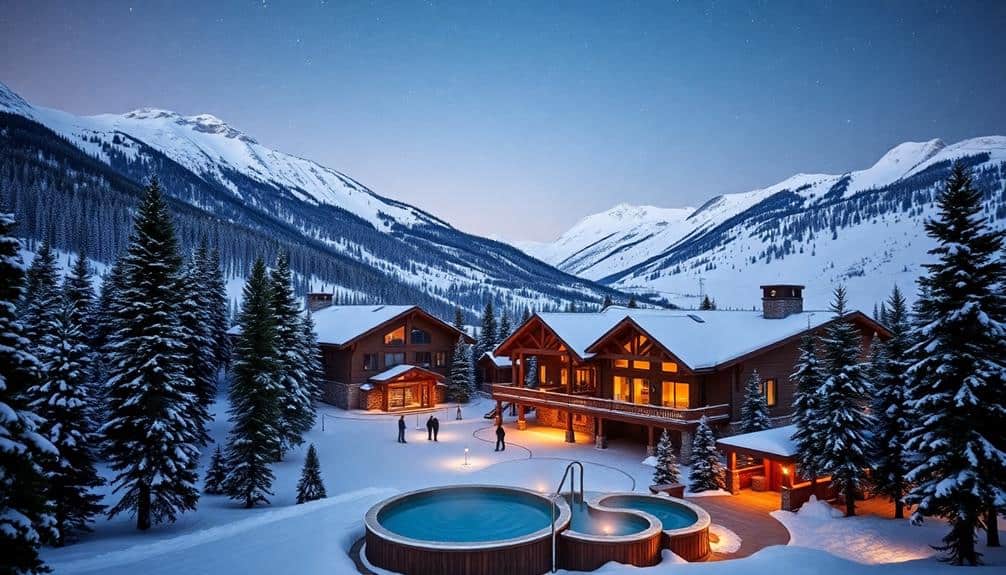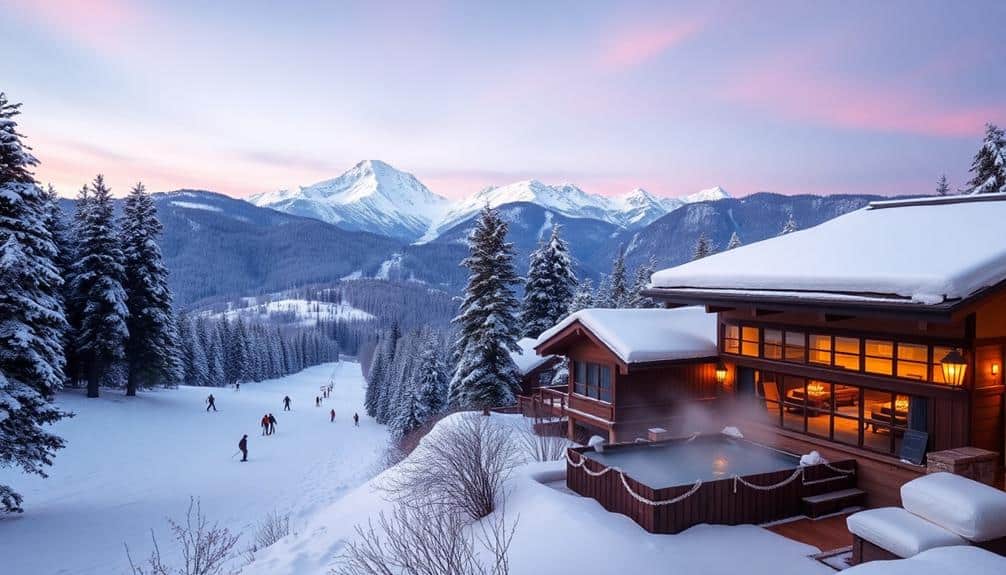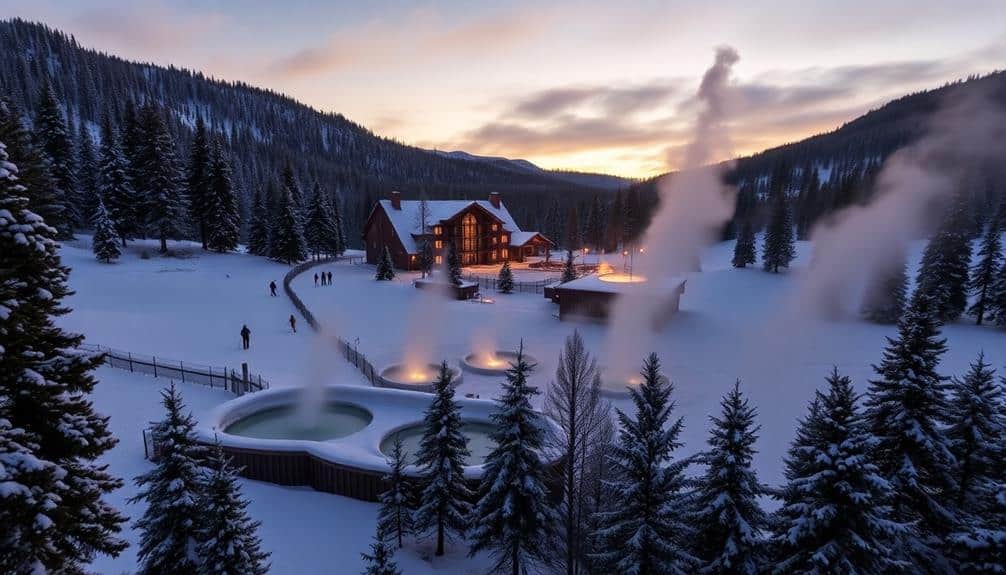
3 Snowy Ski Retreats With Soothing Hot Springs
For a perfect blend of exhilarating slopes and soothing hot springs, consider these three snowy retreats. Banff's Mountain Oasis in the Canadian Rockies offers world-class skiing at Sunshine Village and Lake Louise, complemented by the mineral-rich Banff Upper Hot Springs. Japan's Nagano Prefecture boasts pristine powder at Hakuba and Nozawa Onsen, alongside centuries-old natural hot springs. Colorado's Steamboat Springs combines champagne powder slopes with the rustic Strawberry Park Hot Springs, while Glenwood Springs pairs Sunlight Mountain Resort with the world's largest hot springs pool. Each destination provides unique experiences, from restored ghost towns to private creekside soaks, ensuring an unforgettable winter getaway. Explore further to uncover the distinctive features of each retreat.
In a Nutshell
- Banff, Canada offers world-class skiing and the mineral-rich Banff Upper Hot Springs.
- Nagano, Japan combines pristine powder at Hakuba and Nozawa Onsen with centuries-old natural hot springs.
- Steamboat Springs, Colorado features champagne powder slopes and the rustic Strawberry Park Hot Springs.
- Glenwood Springs, Colorado boasts Sunlight Mountain Resort and the world's largest hot springs pool.
- Dunton Hot Springs, Colorado provides a unique ghost town setting with natural hot springs and nearby skiing.
Banff's Mountain Oasis

Nestled in the heart of the Canadian Rockies, Banff offers a perfect blend of winter sports and relaxation. You'll find world-class ski resorts, including Sunshine Village and Lake Louise, offering diverse terrain for all skill levels. After a day on the slopes, you can soothe your muscles in the Banff Upper Hot Springs, where mineral-rich waters maintain a temperature of 37-40°C (98-104°F) year-round. The springs' facilities include a large pool, steam rooms, and panoramic mountain views. For accommodation, consider the historic Fairmont Banff Springs Hotel, which features its own Willow Stream Spa with waterfall-fed mineral pools. When packing for your trip, don't forget to bring a compact travel steamer to keep your apres-ski attire wrinkle-free. These portable devices are perfect for reviving your clothes after a long day of outdoor activities. Don't miss the opportunity to explore the town's charming streets, lined with boutiques and restaurants serving locally sourced cuisine. Banff National Park also offers winter activities like ice skating on Lake Louise and guided snowshoe tours through pristine wilderness.
Japanese Alps Getaway

A winter wonderland awaits in the Japanese Alps, where you'll find a unique blend of world-class skiing and traditional onsen culture. Nestled in the heart of Nagano Prefecture, resorts like Hakuba and Nozawa Onsen offer pristine powder and extensive trail networks suitable for all skill levels. After a day on the slopes, you can soak your tired muscles in natural hot springs, some dating back centuries. While enjoying the scenic beauty, it is crucial to have proper hiking footwear for exploring the surrounding areas during your stay.
The region's ski areas boast impressive vertical drops, with Hakuba's Happo-one reaching 1,071 meters. Modern lift systems, including high-speed quads and gondolas, guarantee efficient mountain access. Off-piste skiing is available for advanced riders, though always check local avalanche conditions. Many resorts provide English-speaking instructors and rental equipment meeting international standards. For accommodations, choose from Western-style hotels or traditional ryokans, where you'll experience authentic Japanese hospitality and cuisine.
Colorado's Steamy Slopes

Colorado's Rocky Mountains offer a perfect blend of world-class skiing and luxurious hot springs experiences. You'll find numerous resorts that combine these elements, such as Steamboat Springs, where you can carve down champagne powder slopes before soaking in the mineral-rich waters of Strawberry Park Hot Springs. For those seeking ultimate light-blocking comfort during their après-ski naps, consider packing a high-quality travel eye mask to enhance your relaxation experience. At Glenwood Springs, you'll have access to both Sunlight Mountain Resort for skiing and the world's largest hot springs pool for post-slope relaxation. Dunton Hot Springs, near Telluride, provides a unique experience with its restored ghost town setting and natural hot springs. For a more secluded option, consider Mount Princeton Hot Springs Resort, which offers private creekside hot spring pools alongside its ski terrain. These destinations provide varying levels of amenities, from rustic to luxurious, ensuring you'll find the perfect balance of snowy adventure and thermal rejuvenation.
Frequently Asked Questions
What Safety Precautions Should I Take When Using Hot Springs in Winter?
When using hot springs in winter, you'll need to take several precautions. Always check the water temperature before entering, as it can be dangerously hot. Don't submerge your head, and limit your soak time to 15-20 minutes to prevent overheating. Stay hydrated by drinking water before, during, and after your soak. Be cautious of slippery surfaces, and bring warm clothing for when you exit. If you have any health conditions, consult your doctor before using hot springs.
Are There Age Restrictions for Accessing Hot Springs at Ski Resorts?
Like a mosaic of varying rules, age restrictions for hot springs at ski resorts differ widely. You'll find that most resorts allow all ages, but some impose limits, typically restricting children under 12 or 14. It's vital to check the specific resort's policies beforehand. Some facilities offer family-friendly times or separate pools for kids. Always supervise young children, as hot springs can pose risks due to high temperatures and mineral content.
How Do I Prevent My Hair From Freezing After Soaking in Hot Springs?
To prevent your hair from freezing after soaking in hot springs, you'll need to take several precautions. First, apply a leave-in conditioner or hair oil before entering the water to create a protective barrier. After soaking, thoroughly towel-dry your hair and wrap it in a warm, dry towel. You should also wear a insulated hat or beanie to retain heat. If possible, use a portable hair dryer or seek indoor warmth immediately to completely dry your hair before exposing it to freezing temperatures.
Can I Bring My Own Food and Drinks to the Hot Springs?
According to a survey, 78% of hot springs establishments have specific policies regarding outside food and drinks. You'll typically find that most hot springs don't allow you to bring your own food or beverages, primarily due to safety and cleanliness concerns. However, policies can vary widely between locations. It is crucial to check the specific rules of the hot spring you're visiting beforehand. Many facilities offer on-site dining options or designated picnic areas for guests who wish to enjoy their own refreshments.
Are There Any Health Conditions That Prohibit Using Hot Springs While Skiing?
While hot springs can be beneficial, certain health conditions may prohibit their use during skiing. You should avoid hot springs if you have heart problems, low or high blood pressure, or open wounds. Pregnant women, those with diabetes, or individuals prone to dizziness should consult a doctor first. It's essential to stay hydrated, as the combination of skiing and hot springs can lead to dehydration. Always listen to your body and exit the water if you feel lightheaded or uncomfortable.
